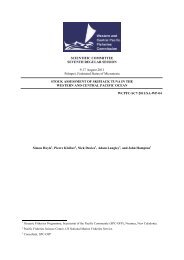The emerging field of electrosensory and semiochemical shark ...
The emerging field of electrosensory and semiochemical shark ...
The emerging field of electrosensory and semiochemical shark ...
You also want an ePaper? Increase the reach of your titles
YUMPU automatically turns print PDFs into web optimized ePapers that Google loves.
8<br />
C.P. O’Connell et al. / Ocean & Coastal Management xxx (2012) 1e10<br />
<strong>and</strong> commercial fishing industries where <strong>shark</strong> densities are<br />
sufficiently low. Lastly, Jordan et al. (2011) examined the deterrent<br />
capabilities <strong>of</strong> an EPM stimulus (NeodymiumeNd) on the smooth<br />
dogfish (M. canis). When tested in groups, M. canis preferred to feed<br />
from EPM-associated baits, whereas individually tested M. canis<br />
were significantly deterred by EPM-associated baits. This demonstrates<br />
that the effectiveness <strong>of</strong> EPMs, or more specifically,<br />
Neodymium on M. canis, may be heavily influenced by conspecific<br />
density. <strong>The</strong>refore, future studies should account for animal density<br />
as these studies illustrate that density-induced behavioral changes<br />
toward <strong>electrosensory</strong> deterrents is plausible.<br />
3.4. Salinity<br />
In regards to EPMs, the conductive medium is an essential<br />
component to the successful transfer <strong>of</strong> cations from the surface <strong>of</strong><br />
the metal to the approaching electronegative <strong>shark</strong>. <strong>The</strong> lower the<br />
resistivity, or opposition <strong>of</strong> electric current, as seen in highly saline<br />
environments (Chave et al., 1991; Eidesmo et al., 2002), will result<br />
in the successful transfer <strong>of</strong> these cations <strong>and</strong> prove the metals to<br />
be more effective (Stroud, 2008a). It is essential that future studies<br />
monitor salinity, as deploying metals in open ocean regions (i.e.<br />
peak salinity) may produce drastically different results in<br />
comparison to estuarine or nearshore environments that are<br />
heavily influenced by freshwater input.<br />
It is uncertain how salinity may impact elasmobranch magnetoreception.<br />
In order for elasmobranch magnetoreception to occur,<br />
two key elements are required for active <strong>and</strong>/or passive electromagnetic<br />
induction: a magnetic <strong>field</strong> (B) <strong>and</strong> velocity (v) (Kalmijn,<br />
1982, 1984). For the active mode <strong>of</strong> electromagnetic induction, the<br />
velocity corresponds to movement <strong>of</strong> the organism through B h<br />
(horizontal portion <strong>of</strong> Earth’s geomagnetic <strong>field</strong>); however, in the<br />
passive mode, the velocity component refers to the velocity <strong>of</strong> the<br />
ocean currents through B v (vertical portion <strong>of</strong> Earth’s geomagnetic<br />
<strong>field</strong>). Although v <strong>and</strong> B are key elements required for elasmobranch<br />
magnetic <strong>field</strong> detection, another element is the conductive<br />
medium that the animal is swimming within (Kalmijn, 1974, 1984,<br />
1997). <strong>The</strong> resistivity <strong>of</strong> seawater <strong>and</strong> freshwater drastically differs,<br />
with freshwater being characterized <strong>of</strong> having a resistivity <strong>of</strong> 2e<br />
200 U m <strong>and</strong> seawater 0.3 U m(Pashley et al., 2005; Chave et al.,<br />
1991; Eidesmo et al., 2002). In lower salinity conditions, the electric<br />
potential gradients between the pore (apical) <strong>and</strong> internal<br />
(basal) structures that are responsible for neural activity, tend to be<br />
minimal thus making the induction mechanism less efficient in<br />
freshwater (Kalmijn, 1974, 1981, 1984). <strong>The</strong>refore, salinity may<br />
impact the magnetoreception capabilities <strong>of</strong> elasmobranchs <strong>and</strong><br />
estuarine, brackish water, or even freshwater ecosystems may not<br />
be ideal ecosystems for magnetic deterrents (Kalmijn, 1974, 1984).<br />
3.5. Animal size/canal length<br />
Ontogentic shifts in electroreceptor sensitivity has been<br />
demonstrated with several elasmobranch species (Sisneros et al.,<br />
1998; Sisneros <strong>and</strong> Tricas, 2002). It is suggested that these shifts<br />
or increases in sensitivity as an animal matures is directly related to<br />
increasing ampullary canal legnth. <strong>The</strong> ampullae <strong>of</strong> Lorenzini<br />
function on voltage gradients, with neurotransmitters being<br />
released to primary afferent neurons when a difference exists<br />
between the pore (apical) <strong>and</strong> internal (basal) potentials (Bennett,<br />
1971; Tricas, 2001). Thus enhanced sensitivity is a function <strong>of</strong> canal<br />
length since greater voltage gradients exist between the pore<br />
surface <strong>and</strong> internal ampullary canal as ampullary canals lengthen.<br />
In addition, previous studies pertaining to the Atlantic stingray<br />
(Dasyatis sabina) <strong>and</strong> clearnose skate (Raja eglanteria) demonstrate<br />
that with maturity there is a gain <strong>of</strong> <strong>electrosensory</strong> primary<br />
afferents <strong>and</strong>, presumably, neural sensitivity (Sisneros et al., 1998;<br />
Sisneros <strong>and</strong> Tricas, 2002). In R. eglanteria, the neural sensitivity<br />
was eight times greater in adults <strong>and</strong> five times greater in juveniles<br />
in comparison to embryos (Sisneros et al., 1998). Similarly, in<br />
D. sabina, the neural sensitivity was four times greater in adults <strong>and</strong><br />
three times greater in juveniles when being compared to embryos<br />
(Sisneros <strong>and</strong> Tricas, 2002). <strong>The</strong>refore, animal size which is related<br />
to ampullary canal length, <strong>and</strong> in some cases, an increase in the<br />
quantity <strong>of</strong> afferent neurons, may influence the success <strong>of</strong> <strong>electrosensory</strong><br />
deterrents, with larger <strong>and</strong> more mature animals having<br />
enhanced sensitivity <strong>and</strong> thus a greater potential to be deterred.<br />
4. Commercial application<br />
Besides assessing the effectiveness <strong>of</strong> these repellents on<br />
interacting species, it is essential to also consider a variety <strong>of</strong> other<br />
characteristics/issues pertaining to these repellents, such as: cost,<br />
safety, pollution, <strong>and</strong> h<strong>and</strong>ling logistics.<br />
4.1. Cost <strong>of</strong> repellents<br />
<strong>The</strong> use <strong>of</strong> certain EPM <strong>and</strong> magnets may be prohibitively<br />
expensive when deployed in large quantities, such as for<br />
commercial fishing hooks. Jordan et al. (2011) proposed the use <strong>of</strong><br />
neodymium metal due to its <strong>field</strong> strength <strong>and</strong> relative cost in<br />
comparison to other lanthanide metals, but it is likely that using<br />
a pure lanthanide metal in a commercial fishery is economically<br />
impractical. While the PEW Institute (Cos<strong>and</strong>ey-Goden <strong>and</strong><br />
Morgan, 2011) conclude that “significant cost” precludes EPMs as<br />
an “economically viable option”, the authors fail to consider<br />
abundant <strong>and</strong> cost-effective reactive metals. Metals with a higher<br />
reduction potential at a fraction <strong>of</strong> the cost <strong>of</strong> pure lanthanides have<br />
been shown to be effective (O’Connell et al., submitted for<br />
publication). Magnesium <strong>and</strong> certain magnesium alloys, at $0.05<br />
US/gram in quantity for 99% þ purity, are much more practical <strong>and</strong><br />
easier to fabricate for fishing gear requirements.<br />
4.2. Magnet-associated issues<br />
Besides varying successes with magnetic repellents (Rigg et al.,<br />
2009; O’Connell et al., 2010, 2011a, 2011b), there exists a variety <strong>of</strong><br />
issues which one must consider prior to implementation <strong>and</strong>/or<br />
application. (1) When working in close proximity to neodymiume<br />
ironeboron <strong>and</strong> bariumeferrite magnets on a research vessel or<br />
platform, these magnets can be prohibitively difficult to work with<br />
<strong>and</strong> potentially very dangerous <strong>and</strong> cause bodily harm if a finger or<br />
other body part becomes trapped between two magnets. (2) <strong>The</strong>se<br />
materials have the ability to permanently destroy electronic<br />
equipment (e.g. cameras <strong>and</strong> computers) <strong>and</strong> thus should be<br />
h<strong>and</strong>led with care. (3) When applying magnets directly to a fishing<br />
hook, the presence <strong>of</strong> this large visual stimulus (e.g. the magnet)<br />
may potentially interfere with target catch unless hooks are<br />
magnetized thus removing the visual component. (4) If applying<br />
magnets directly to fishing hooks or for beach net-associated<br />
applications, it is inevitable that some magnets will be lost<br />
causing pollution. (5) Lastly, it is currently not understood how<br />
exposing organisms to strong magnetic <strong>field</strong>s may impact their<br />
electroreception <strong>of</strong> navigational capabilities <strong>and</strong> thus prior to<br />
commercial application this topic should be extensively studied.<br />
4.3. EPM-associated issues<br />
EPMs have shown promise in both laboratory (Stoner <strong>and</strong><br />
Kaimmer, 2008; Brill et al., 2009; Jordan et al., 2011) <strong>and</strong> <strong>field</strong><br />
experimentation (Kaimmer <strong>and</strong> Stoner, 2008; Wang et al., 2008).<br />
Please cite this article in press as: O’Connell, C.P., et al., <strong>The</strong> <strong>emerging</strong> <strong>field</strong> <strong>of</strong> <strong>electrosensory</strong> <strong>and</strong> <strong>semiochemical</strong> <strong>shark</strong> repellents: Mechanisms <strong>of</strong><br />
detection, overview <strong>of</strong> past studies, <strong>and</strong> future directions, Ocean & Coastal Management (2012), http://dx.doi.org/10.1016/<br />
j.ocecoaman.2012.11.005




